Below the Waist

Most skin conditions that can occur above the waist may also occur also below the waist. While skin problems are never pleasant, when they strike near a sensitive place, they can be downright scary. Some genital skin problems should prompt a trip to the doctor or dermatologist's office, while many others are no big deal. But how can you know which is which?
In the following article, you will learn about more common skin conditions found below the waist and get familiar with some of the many ways your private areas can be irritated, inflamed, or be just plain odd due to conditions that may or may not be cause for alarm. Flare-ups may be due to allergies, dermatitis, skin conditions, and other disorders. Learn what's common and what's unusual, what's benign and what's potentially harmful, and gather tips along the way that can lead you to better medical health.
Razor Burn and Ingrown Hairs

What Is It?
If you have symptoms of tiny lumps or bumps just beneath the skin in your vaginal area that are itchy or red, you may simply have ingrown hairs or razor burn. The redness that accompanies them is caused by inflammation. The bump itself is filled with pus. These bumps can be picked up from shaving or sometimes appear because the hair follicle is clogged with dead skin and surface oils. Curly hairs are especially prone to this problem.
Is it Dangerous?
Although they can be itchy, ingrown hairs aren't especially harmful. These itchy bumps are a common reason that people go to the dermatology office.
What Should I Do?
Don't pick at them. A doctor can diagnose razor burn and ingrown hairs by considering your medical history and by performing a physical exam. They often heal on their own. You can avoid them by letting the hair grow longer before shaving, trimming the hair rather than shaving, or removing the hair through electrolysis or other methods besides shaving.
Cysts
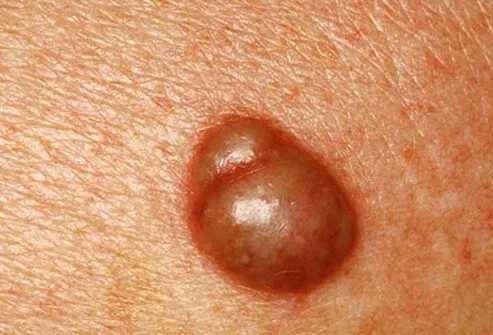
What Is It?
If you spot a small, round lump or bulge beneath your epidermis that you can move around easily, you may be dealing with a cyst. Cysts tend to be either whitish-yellow or the same as your flesh tone. They usually stay about the same size, although they may grow slightly. When infected, cysts become boils, which are described later. Cysts are common. They can either be filled with pus, air, fluid, or other material. Many things can cause a cyst, including popped blood vessels, cell defects, blocked ducts, and parasites.
Is it Dangerous?
Most cysts are benign. Some, however, may indicate cancer. Even when benign, untreated cysts can cause serious problems, including blood poisoning.
What Should I Do?
Any unusual lump requires examination by a doctor to determine what kind of skin disorder you have. Treatments vary depending on the type of cyst. Most treatments involve surgical removal by a dermatologist or other physician.
Boils
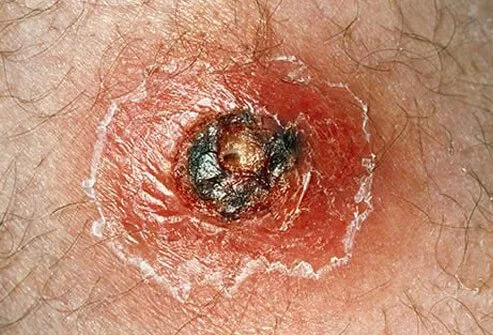
What Is It?
Boils are painful lesions caused by bacterial infection. They are pus-filled and typically firm. They commonly appear in the groin, buttocks, and waist. When they form in clusters, boils are called carbuncles.
Is it Dangerous?
Usually boils don't cause any further problems, but there are exceptions. Sometimes larger boils leave scars. The bacteria inside a boil may also spread throughout the body. This could lead your blood, heart, joints, or other areas to become infected. Very rare life-threatening complications such as sepsis are possible.
What Should I Do?
Ask your doctor for a medical diagnosis of your skin disease. A trained physician can culture the boil so the bacterial cause can be identified. Once this is known, your doctor can recommend a suitable treatment, which may include antibiotics, a warm compress, or surgical removal.
Skin Tags

What Is It?
Do you see little, fleshy flaps hanging from your body? Those could be skin tags. These flesh-colored growths are particularly common in people over age 60, especially if they have gained weight. Pregnant women are also prone to skin tags. They often appear beneath the breasts or around the genital area.
Is it Dangerous?
No. Skin tags do not cause pain, though they can become irritated if they are rubbed frequently. They do not indicate cancer and cannot become skin cancer.
What Should I Do?
If your skin tags bother you, show them to a doctor. A doctor will quickly recognize them and can suggest treatments. A doctor or dermatologist can remove these growths with a sharp blade or scissors, or sometimes by freezing or burning. Because they are considered a cosmetic issue rather than a health concern, these procedures are usually not covered through insurance.
Angiomas

What Is It?
Angiomas are growths of small blood vessels. They come in many different shapes and types. Some of the more typical forms include cherry angiomas, which are caused by aging. These tiny papules have a bright cherry-red appearance, hence the name. Another commonplace form is the spider angioma, which grows just below the fleshy surface of your body. Spider angioma symptoms may include a red dot in the center of the growth, along with reddish fingers that stretch outward from their centers.
Is it Dangerous?
Not really. Angiomas are non-cancerous, and they don't need to be treated unless they are bleeding or otherwise bothering you.
What Should I Do?
Angiomas can be treated in a dermatology practice with lasers, liquid nitrogen, or electrodessication (an electric needle which destroys the angioma blood vessels).
Mollusca

What Is It?
Mollusca are painless, pearl-like lesions that form after infection from a virus. They usually occur in clusters. While small children are usually infected, it can also sometimes affect teens and adults. It is spread through contact, including sexual contact, making it a sexually-transmitted infection (STI). It can also be spread by sharing towels, bedding, and other personal items. Adults tend to develop these on the vulva, penis, stomach, and inner thighs. Sometimes they are confused with herpes, but while herpes is quite painful, Mollusca symptoms cause no pain.
Is it Dangerous?
Mollusca themselves are generally harmless. They may itch, and they do occasionally leave a small scar after they go away, but this is unusual. However, when many Mollusca or especially large Mollusca are found, this may indicate an underlying problem with your immune system.
What Should I Do?
Leave them alone. Mollusca usually go away on their own after a few months to a year and a half. Healing time for this skin condition can be prolonged by picking at the lesions, as this helps spread the virus to new areas. If you are unsure about the cause of these lesions, see your doctor.
Genital Warts
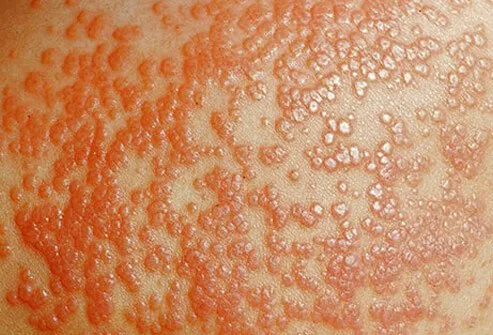
What Is It?
Genital warts are tiny, fleshy growths that are usually flat and usually develop around the shaft of the penis or under the foreskin in men and around the vaginal entrance in women. This skin infection can also develop on the vulva, cervix, scrotum, groin area, and both inside and around the anus. Genital warts are caused by the human papillomavirus (HPV) and are spread through sexual contact, making them a sexually transmitted infection (STI). They may be so small as to be invisible to the naked eye. This growth sometimes resembles a cauliflower top. This is a common genital disease. In fact, most adults who are sexually active will contract HPV at some point in their lives.
Is it Dangerous?
Although HPV is the leading cause of cervical cancer, the type of HPV that causes genital warts is not linked to cancer, except in very rare and unusual cases. Rarely, genital warts can cause vaginal bleeding, itching, discharge, or an increase in dampness near the site of the warts. The virus has also been linked to the development of prostate cancer.
What Should I Do?
Only a doctor can treat vaginal warts—so don't bother with over-the-counter wart medicines, which are not recommended for this condition. A doctor may prescribe medicine for genital warts or remove them through surgery, freezing, burning, or laser therapy. HPV infections often go away after a time. But even after a person's warts have been treated, they still carry the virus and remain infectious to other partners.
Keratosis Pilaris
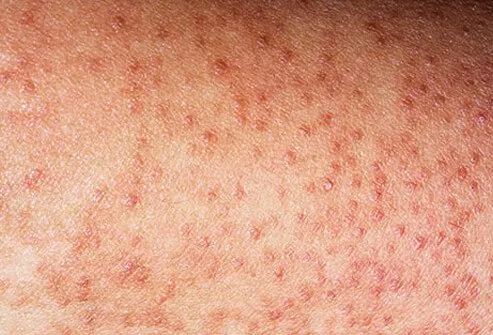
What Is It?
In this common skin condition, tiny, rough bumps develop that appear similar to a plucked chicken. Keratosis pilaris (KP) tends to arise on the buttocks and the front of the thighs. These bumps are made up of dead skin cells. This condition can be itchy and dry. About half of all children have KP, and it is most frequently found among teenagers, though it can appear at any age. It is often found on dry skin. KP is sometimes confused with psoriasis, but the autoimmune disorder psoriasis, characterized by layers of silvery scales, is potentially more serious. Another skin condition that causes scaly skin is ichthyosis. Ichthyosis is a group of rare genetic skin disorders.
Is it Dangerous?
Keratosis pilaris is not especially harmful, although it can leave atrophy, scarring, and hair loss.
What Should I Do?
There is no cure for KP. A few treatments may be useful, however, including non-soap cleansers, exfoliation, moisturizing creams, laser treatment, and laser-assisted hair removal so skin doesn't keratose in the first place.
Folliculitis (Shaving Bumps)
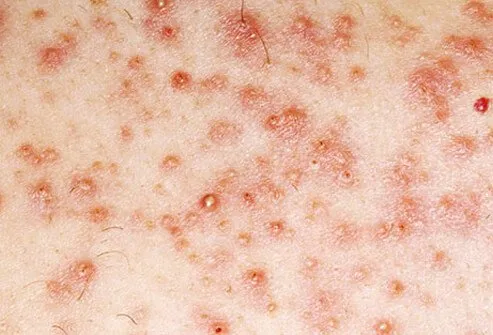
What Is It?
It could be shaving bumps. Folliculitis resembles acne pimples or crusty sores that won't heal. But this condition is actually what results from the hair follicles becoming infected. The infection may be caused by a bacteria, yeast, fungus, parasite, or virus. It can also be caused by paraffin-based moisturizers, certain chemicals like coal tar, and topical steroids. Women often get this after shaving, waxing, or plucking leg hairs, or following electrolysis. Other names for the condition include pseudofolliculitis barbae, barber's itch, razor bumps, folliculitis barbae traumatica, and scarring pseudofolliculitis of the beard. It is a common skin problem.
Is it Dangerous?
Although the site of folliculitis can be tender and itchy, it is otherwise harmless.
What Should I Do?
Treatment depends on the cause. Sometimes antibiotics are prescribed, taken either orally or topically. If the cause is shaving, stopping shaving for at least three months will allow the hair time to grow back in a healthy way. Switching to an electric razor can help prevent folliculitis from reoccurring.
Syphilis
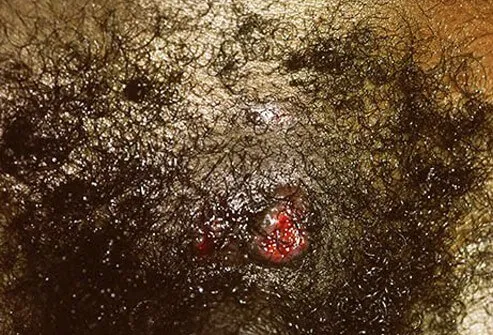
What Is It?
When it first appears, symptoms of the sexually transmitted bacterial infection syphilis include a painless sore on your penis, vulva, anus, rectum, lips, or mouth called a chancre. This is the first stage, in which it is very contagious. In the second stage of syphilis, symptoms include flat, wart-shaped growths that do not itch.
Is it Dangerous?
If untreated, this condition can become extremely serious, leading to blindness, paralysis, dementia, and death. Fortunately, it is easily treatable with antibiotics.
What Should I Do?
A doctor can diagnose syphilis with a blood test in most cases. Antibiotics will cure the condition, but this does not protect you from future infections of the disease. Although curable, any damage done by the syphilis bacteria cannot be reversed.
Genital Herpes

What Is It?
Genital herpes symptoms include painful, fluid-filled sores on the rectum, genitals, and, potentially, on the mouth. Before these sores appear, men and women with the disease often experience a tingling sensation around the thighs, buttocks, and genitalia. The sores and accompanying symptoms come and go.
Genital herpes (HSV-2) is similar to oral herpes (HSV-1), but there are important differences as well. Both are caused by the herpes simplex virus. HSV-1 typically results in cold sores around the mouth, but can sometimes be spread to the genitals. HSV-2 is more often spread through sexual contact, though it can also be spread to the mouth. Both types of HSV are quite prevalent. In the US, as many as 90% of the adult population has HSV-1, and about one out of every six people between 14 and 49 years of age has HSV-2.
Is it Dangerous?
HSV-2 can increase the likelihood for other health risks to occur. Pregnant women with the condition should inform their doctors, as it presents several dangers to the child, including miscarriage, premature birth, and the spread from mother to child of a potentially deadly infection known as neonatal herpes. Additionally, because herpes sores can bleed easily, they increase the risk of spreading or contracting HIV if either sexual partner is HIV-positive.
What Should I Do?
Genital herpes cannot be cured. However, there are ways to minimize the symptoms of the condition, as well as ways to reduce the risk of spreading the disorder to others. Talk to your doctor about your infection, and ask about medication that can shorten or even prevent outbreaks.
You can still be sexually active with an HSV-2 infection. It's important to tell your partner, as well as the risks involved. Condoms reduce the risk of spreading HSV-2, but do not eliminate the risk, as uncovered body parts can still spread the virus. Although the risk of spreading HSV-2 increases during an outbreak, the disease can still be spread while it is dormant.
Skin Cancer
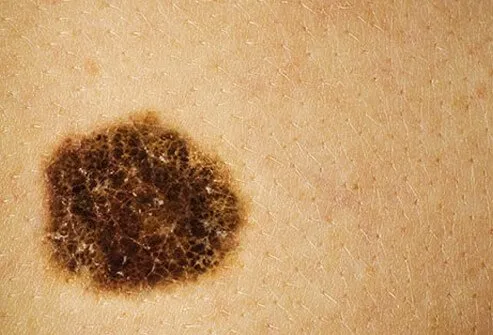
What Is It?
There are many forms of skin cancer, and they come in different colors, sizes, and shapes. Dermatologists recommend examining your body for any new growths, moles, or any existing lesions that begin to bleed, itch, change, or fail to heal.
There are more specific guidelines when looking for melanoma, a particularly dangerous form of skin cancer. These involve what's called the ABCDEs of melanoma:
- A – Asymmetry: If you see a spot, imagine drawing a line through its center. Do both sides match? If not, you have spotted a warning sign of melanoma.
- B – Border: The borders of a melanoma spot tend to be uneven, with grooves, notches, and scallop patterns common. Benign spots tend to have even borders.
- C – Color: A spot with more than one color is a warning sign for melanoma cancer. These colors can include brown, black, tan, white, red, and blue.
- D – Diameter: Melanoma spots usually have a larger diameter than the eraser at the end of a pencil, though they may be smaller when first detected.
- E – Evolving: Safe spots stay the same over time. Dangerous melanoma tends to change over time. Watch out for changes in shape, size, color, elevation, or for a spot to suddenly begin bleeding, crusting, or itching. These are all dangerous signs.
Is it Dangerous?
Yes, all skin cancers are potentially dangerous. Some forms are more dangerous than others, though. Basal cell carcinoma is the most common form, and it is rarely life-threatening. It can be disfiguring, however, and should be treated seriously. Squamous cell carcinoma is another type of skin cancer that is more invasive than basal cell carcinoma. They look like scaly red patches, warts, open growths, or elevated growths that have a depression in the center. Although less common, melanoma is the most deadly form of skin cancer. Early detection is crucial to surviving melanoma.
What Should I Do?
Ask your doctor for a diagnosis. He or she will check for signs of skin cancer and recommend treatments. Once-a-month self-examinations are also recommended. In a well-lit room, stand in front of a full-length mirror. For hard-to-see areas, use a handheld mirror. Look for the ABCDEs as described above.
Lichen Sclerosus

What Is It?
Lichen sclerosus is a long-term skin condition with an unknown cause. It can appear in anyone, but is most common in postmenopausal women. It appears as tiny white spots that grow into bigger patches. The skin then becomes thin and crinkly, and tears and bruises easily. Mild cases may have no symptoms, though. Other symptoms can include pain, bleeding, and blisters. Itching is very common. Lichen planus is an autoimmune inflammatory disorder that can affect the vagina and the vulva. Lichen planus causes itchy, purple, flat bumps.
Is it Dangerous?
When lichen sclerosus occurs in the genital area, it should be treated, as it may affect sexual intercourse and urination. In rare cases, lichen sclerosus scars may encourage the growth of skin cancer. When the condition is found on the arms or upper body, it does not need to be treated most of the time. The patches will go away over time in these cases.
What Should I Do?
Ask your doctor for a medical diagnosis if you suspect you may have lichen sclerosus on your genital area. Men with this disease may find relief following circumcision. Surgery will most likely not work for women and girls, however. Sometimes powerful cortisone creams or ointments are used as treatments. You will want to follow up with a doctor if you use a cortisone treatment, as these medications can cause several health problems if they are applied for a long time.
Skin Problems: Skin Conditions Below the Waist
This tool does not provide medical advice. See additional information: 
© 1996-2024 WebMD, LLC. All rights reserved.
